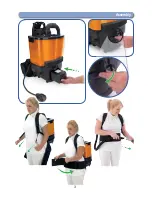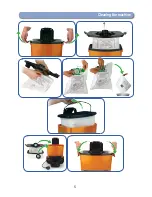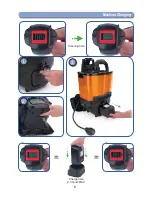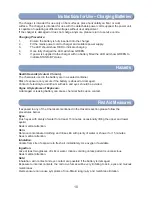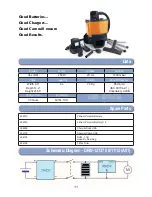
10
The charger is intended for use only on flat surfaces, place horizontally on floor or work
surface. The charger is intended for use with the detachable power cord supplied, the power unit
is capable of operating at different voltages without user adjustment.
If the charger is damaged or does not charge anymore, please return to service centre.
Charging Procedure:
1.
Ensure the battery is fully inserted into the charger.
2.
Fit the mains power cord to charger and suitable power supply.
3.
The LED should show RED to indicate charging.
4.
Once fully charged the LED will show GREEN.
5.
If power is supplied to the charger with no battery fitted the LED will show GREEN to
indicate STAND-BY status.
Instructions for Use – Charging Batteries
Hazards
Health Hazards (Acute & Chronic).
The chemicals used in the battery are in a sealed container.
Risk of exposure only occurs if the battery is abused or damaged.
Contact of electrolyte and lithium with skin and eyes should be avoided.
Signs & Symptoms of Exposure.
A damaged or leaking battery can cause chemical burns upon contact.
If exposed to any of the Chemicals mentioned in the Hazards section please follow the
procedures below:
Eyes.
Flush eyes with plenty of water for at least 15 minutes, occasionally lifting the upper and lower
eyelid.
Seek medical attention.
Skin.
Remove contaminated clothing and rinse skin with plenty of water or shower for 15 minutes.
Seek medical attention.
Inhalation.
Vacate from site of exposure to fresh air immediately. Use oxygen if available.
Ingestion.
Give at least two glasses of milk or water. Induce vomiting unless patient is unconscious.
Seek medical attention.
Note:
Inhalation, skin contact and eye contact are possible if the battery is damaged.
Exposure to internal contents, the corrosive fumes will be very irritating to skin, eyes and mucous
membranes.
Overexposure can cause symptoms of non-fibroid lung injury and membrane irritation.
First Aid Measures



